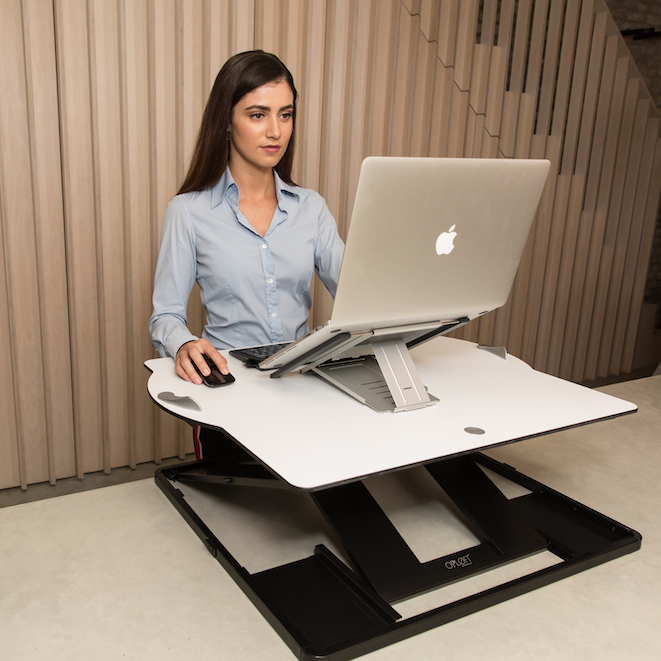
Choosing a chair is a personal thing. We all like different styles and colours - and we all have different body shapes - but there are some basic principles that can guide you to a good choice.
A good work chair should:
- Support you when working or taking short breaks from work.
- Allow you to move freely and allow you to work comfortably and efficiently.
- Accommodate and support your body shape and anyone else who will use it regularly.
- Correspond with your work area, especially the height of the table or desk, and the layout of the equipment on it.
The longer you’re using a chair, the more important it is that you get this decision right, cutting corners on something you may use all day is not a wise decision.
Chair buying checklist
When buying a chair, check the following factors:
Seat height – Can you easily adjust the height so you are sitting with your arms at a right-angle to your work surface? If your feet don’t rest flat on the floor, use a footrest.
When you’re working at a desk or table which can’t be adjusted in height, adjust your chair according to the height of your desk, adjusting the chair until your elbows are just above the top so your forearms are parallel to the floor and your wrists are in a neutral position.
Seat width and depth – Can you fit two to four fingers between the back of your knee and the chair seat? If the space is too tight you’ll impede the blood supply to your legs and feet. When sitting at the correct height you should have a slight downward slope on your thighs with your hips slightly higher than your knees. It is not advisable to sit with your knees higher than your hips.
Back support – Does the backrest fit the contours of your spine? And do you feel well supported? Consider a chair with an inbuilt inflatable lumbar cushion so you can find the perfect amount of support for you. Back support in a chair is very important. The lumbar spine area (lower part of your back) should have a slight inward curve. Sitting for long periods without support for this curve tends to put pressure on the structures in the lower spine, causing short term discomfort and longer term pain.
Backrest tilt – Is there a function that allows you to tilt the backrest to suit your needs? Tilting the backrest allows you to adopt different postures e.g. upright, or semi-reclined. When you sit on a work chair, the angle between your thighs and back should be around 95 to 120 degrees. Keeping this angle or increasing it lets you breathe well and helps to maintain a good spinal position.
Armrests – If you have armrests, do they allow your arms to rest comfortably with your shoulders relaxed? It’s also important that they do not get in the way of your work and hinder your position.
Seat material – Does the chair have enough padding to be comfortable? Having a fabric that breathes is preferable to a harder surface. Some chairs with mesh do not provide adequate support. As the mesh ages it can lose its tension, and if you’re in an area with draughts you might find yourself feeling chilly in a chair with a mesh back.
Movement- Some chairs feature a movement mechanism allowing the chair to move with your body to stimulate blood-flow and oxygen. Chairs that provide movement should work relative to your weight to provide suitable support so they should have either a way of adjusting the tension or have an auto weight adjustment. When these chairs are correctly adjusted whether you’re upright or leaning back, you should be able to maintain a good posture without having to exert excessive force or feel that you are being push forwards.
Investing in a new chair is an important decision. This is the tool you’ll be using on a daily basis. If it’s not comfortable, chances are it’s going to cause you problems that affect your health and productivity. It’s helpful if you can trial the chair and return if it’s not suitable. Be aware that if your new chair puts you in different position then it may take a few days to get used to the feel of it.
You can book a workstation assessment with one of our trained assessors to help you find better positions to reduce the risk of musculoskeletal disorders and ensure you’re getting the most out of your chair. If you’re buying chairs for multiple people, please contact our projects team by visiting posturite.co.uk/projects.
About Posturite
Posturite is the largest independent ergonomics company in the UK. Ergonomic products are designed to work with your body to help you carry out tasks as comfortably and safely as possible.
But providing ergonomic products is just the start of what the company does. Over the last 27 years of business, they’ve branched out into DSE, health and safety, staff training, office refurbishment, assistive tech and more.
All the products and services Posturite offers are designed to improve the health of businesses by protecting the health, safety and wellbeing of the people who work for them.
For further information, please visit www.posturite.co.uk





